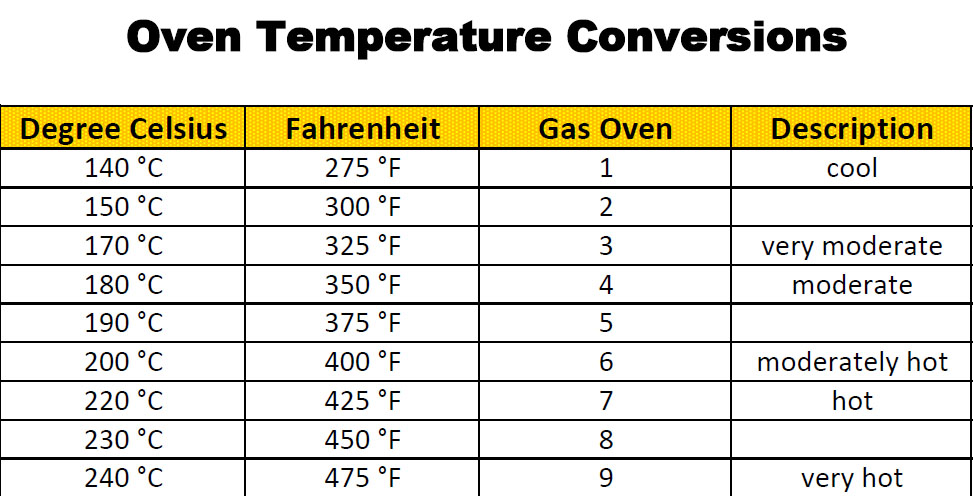Mastering Oven Temperatures A Guide to Conversion and Timing

Have you ever been midway through a recipe, only to realize the temperature is in Celsius and your oven is set to Fahrenheit? Or perhaps you've found a baking time for a fan oven but you have a conventional one? Understanding oven temperature conversions and adjusting cooking times is crucial for successful cooking and baking.
Temperature conversions in cooking are more than just substituting numbers; they are the key to unlocking consistent and predictable results. A seemingly small difference of a few degrees can dramatically alter the outcome of a dish. Imagine a delicate cake, meant to be light and airy, turning dense and heavy due to a miscalculation in temperature. Or a roast, intended to be succulent and juicy, becoming dry and overcooked. These scenarios highlight the importance of accurate temperature conversions.
The history of cooking temperature conversions is intertwined with the development of standardized temperature scales and cooking appliances. As ovens evolved from wood-fired hearths to gas and electric models, the need for precise temperature control became paramount. Early recipes often relied on vague descriptions like "moderate heat" or "hot oven," leaving much to interpretation. The advent of Fahrenheit and Celsius scales provided a more scientific approach, paving the way for more precise cooking. However, the challenge of converting between these scales, and accounting for the nuances of different oven types, persists.
One of the main issues surrounding temperature conversion charts is their sometimes oversimplified nature. They often provide a straight conversion between Fahrenheit and Celsius without accounting for the specific characteristics of different ovens. For instance, fan-assisted ovens tend to cook hotter and faster than conventional ovens, requiring adjustments beyond a simple temperature conversion. Similarly, the material and size of the cookware can influence cooking times, further complicating the process.
Navigating the world of oven temperature conversions can initially seem daunting, but with a little practice and understanding, it becomes an essential tool in every cook's arsenal. It allows you to adapt recipes from different sources, experiment with new techniques, and ultimately, achieve culinary success.
Converting between Fahrenheit and Celsius involves using specific formulas. To convert Celsius to Fahrenheit, multiply the Celsius temperature by 9/5 and add 32. Conversely, to convert Fahrenheit to Celsius, subtract 32 from the Fahrenheit temperature and multiply by 5/9. For example, 180°C is equivalent to 356°F, and 350°F is approximately 177°C.
One benefit of understanding temperature conversions is the ability to use recipes from around the world. Many international recipes use Celsius, so if your oven operates on Fahrenheit, conversion is essential. Another benefit is adapting recipes for different oven types. If a recipe is written for a conventional oven but you have a fan oven, you can adjust the temperature and time accordingly. Lastly, accurate conversions allow for predictable results, ensuring your dishes turn out as intended.
A successful approach to temperature conversion involves understanding your oven. Perform a temperature test to ensure your oven’s display accurately reflects the actual temperature. Consult reliable conversion charts and consider the type of oven you are using. When adjusting cooking times, start by reducing the recommended time slightly, as hotter or fan-assisted ovens tend to cook faster.
Advantages and Disadvantages of Temperature Conversion Charts
| Advantages | Disadvantages |
|---|---|
| Accessibility and ease of use | Oversimplification and lack of nuance |
| Facilitate use of international recipes | May not account for specific oven variations |
Best practices include using a reliable thermometer, testing your oven's accuracy, consulting reputable conversion charts, and considering oven type and recipe specifics. Always start with slight adjustments to cooking time when converting temperatures.
Examples of conversion include baking a cake at 160°C (fan oven) instead of 180°C (conventional), roasting a chicken at 375°F instead of 190°C, and adapting baking times for different pan sizes.
Challenges include inaccurate oven thermostats, variations in oven types, and recipe ambiguities. Solutions involve calibrating ovens, understanding oven characteristics, and consulting reputable resources for guidance.
FAQs: What is the formula for converting Celsius to Fahrenheit? How do I adjust cooking times for different oven types? Where can I find reliable temperature conversion charts? Why is it important to use an oven thermometer? What are the common mistakes to avoid when converting temperatures? How can I adapt recipes from different countries? What is the difference between a fan oven and a conventional oven? How do I test my oven's accuracy?
Tips: Invest in an oven thermometer. Test your oven's temperature regularly. Use reliable conversion charts. Understand the difference between oven types. Start with small adjustments to cooking times.
Mastering oven temperature conversions and cooking time adjustments empowers you to confidently tackle any recipe. It allows you to explore diverse culinary traditions, adapt recipes to your specific equipment, and ultimately achieve consistent and delicious results. From baking delicate pastries to roasting hearty meats, precise temperature control is the foundation of successful cooking. By embracing accurate conversions and understanding the nuances of different ovens, you unlock a world of culinary possibilities and elevate your cooking to the next level. Don't be afraid to experiment and adjust as needed. With practice and a keen understanding of your oven, you'll be well on your way to creating culinary masterpieces. Remember, a well-calibrated oven and a reliable conversion chart are your allies in the kitchen. Embrace them and enjoy the journey of culinary exploration.
Black clover manga conclusion unveiled
The sss class ranker returns a must read
Discovering the elk river trail east trailhead your gateway to adventure













